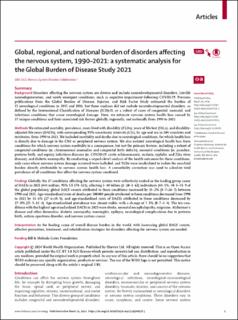Global, regional, and national burden of disorders affecting the nervous system, 1990–2021: a systematic analysis for the Global Burden of Disease Study 2021
Steinmetz, Jaimie D; Seeher, Katrin Maria; Kisa, Adnan; Schiess, Nicoline; Nichols, Emma; Kisa, Sezer; Cao, Bochen; Servili, Chiara; Cavallera, Vanessa; Disorders Collaborators, GBD 2021 Nervous System
Peer reviewed, Journal article
Published version
Permanent lenke
https://hdl.handle.net/11250/3122761Utgivelsesdato
2024Metadata
Vis full innførselSamlinger
Sammendrag
Background Disorders affecting the nervous system are diverse and include neurodevelopmental disorders, late-life
neurodegeneration, and newly emergent conditions, such as cognitive impairment following COVID-19. Previous
publications from the Global Burden of Disease, Injuries, and Risk Factor Study estimated the burden of
15 neurological conditions in 2015 and 2016, but these analyses did not include neurodevelopmental disorders, as
defined by the International Classification of Diseases (ICD)-11, or a subset of cases of congenital, neonatal, and
infectious conditions that cause neurological damage. Here, we estimate nervous system health loss caused by
37 unique conditions and their associated risk factors globally, regionally, and nationally from 1990 to 2021.
Methods We estimated mortality, prevalence, years lived with disability (YLDs), years of life lost (YLLs), and disability-
adjusted life-years (DALYs), with corresponding 95% uncertainty intervals (UIs), by age and sex in 204 countries and
territories, from 1990 to 2021. We included morbidity and deaths due to neurological conditions, for which health loss
is directly due to damage to the CNS or peripheral nervous system. We also isolated neurological health loss from
conditions for which nervous system morbidity is a consequence, but not the primary feature, including a subset of
congenital conditions (ie, chromosomal anomalies and congenital birth defects), neonatal conditions (ie, jaundice,
preterm birth, and sepsis), infectious diseases (ie, COVID-19, cystic echinococcosis, malaria, syphilis, and Zika virus
disease), and diabetic neuropathy. By conducting a sequela-level analysis of the health outcomes for these conditions,
only cases where nervous system damage occurred were included, and YLDs were recalculated to isolate the non-fatal
burden directly attributable to nervous system health loss. A comorbidity correction was used to calculate total
prevalence of all conditions that affect the nervous system combined.
Findings Globally, the 37 conditions affecting the nervous system were collectively ranked as the leading group cause
of DALYs in 2021 (443 million, 95% UI 378–521), affecting 3·40 billion (3·20–3·62) individuals (43·1%, 40·5–45·9 of
the global population); global DALY counts attributed to these conditions increased by 18·2% (8·7–26·7) between
1990 and 2021. Age-standardised rates of deaths per 100 000 people attributed to these conditions decreased from 1990
to 2021 by 33·6% (27·6–38·8), and age-standardised rates of DALYs attributed to these conditions decreased by
27·0% (21·5–32·4). Age-standardised prevalence was almost stable, with a change of 1·5% (0·7–2·4). The ten con-
ditions with the highest age-standardised DALYs in 2021 were stroke, neonatal encephalopathy, migraine, Alzheimer’s
disease and other dementias, diabetic neuropathy, meningitis, epilepsy, neurological complications due to preterm
birth, autism spectrum disorder, and nervous system cancer.
Interpretation As the leading cause of overall disease burden in the world, with increasing global DALY counts,
effective prevention, treatment, and rehabilitation strategies for disorders affecting the nervous system are needed.

